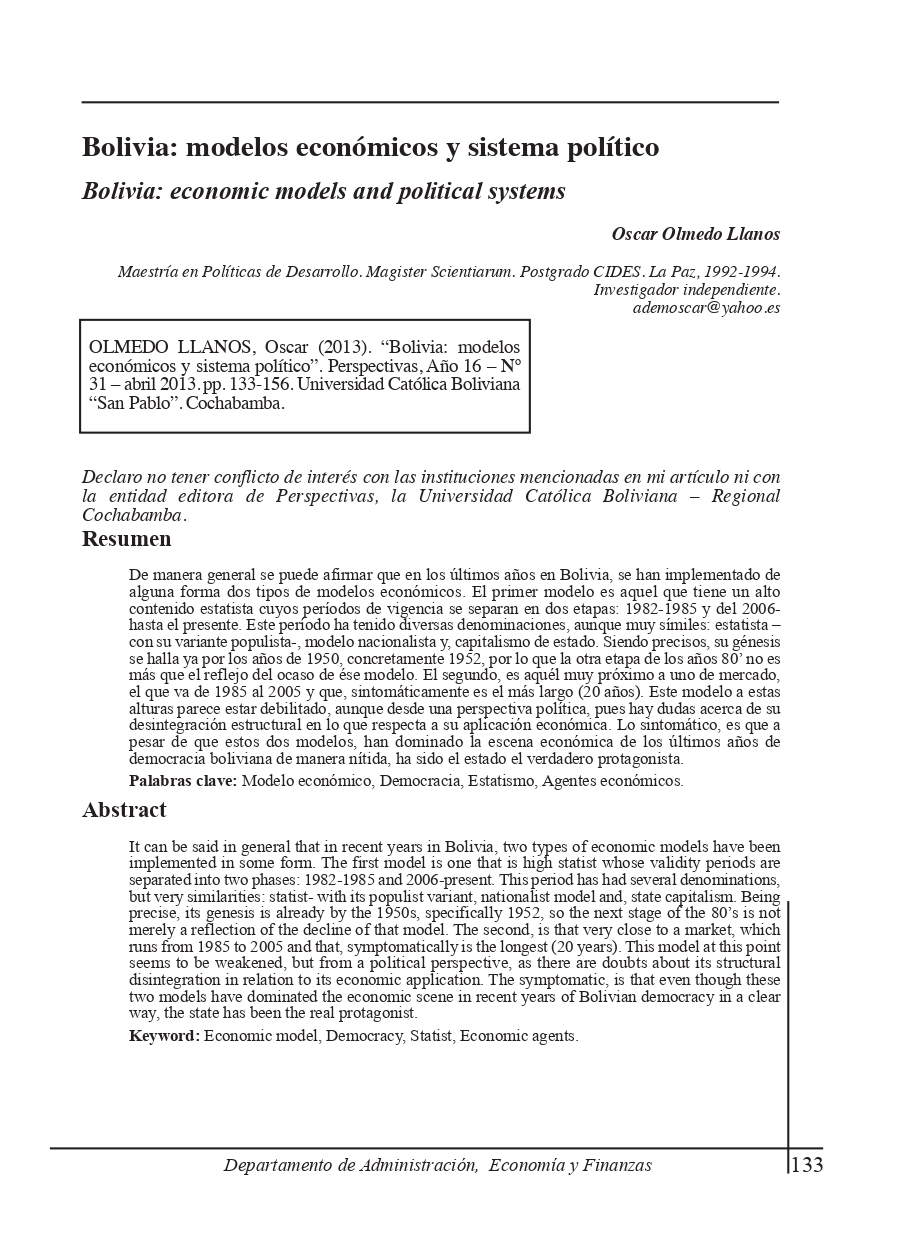Bolivia: economic models and political systems
DOI:
https://doi.org/10.35319/g0870753Keywords:
Economic model, Democracy, Statist, Economic agentsAbstract
It can be said in general that in recent years in Bolivia, two types of economic models have been implemented in some form. The first model is one that is high statist whose validity periods are separated into two phases: 1982-1985 and 2006-present. This period has had several denominations, but very similarities: statist- with its populist variant, nationalist model and, state capitalism. Being precise, its genesis is already by the 1950s, specifically 1952, so the next stage of the 80’s is not merely a reflection of the decline of that model. The second, is that very close to a market, which runs from 1985 to 2005 and that, symptomatically is the longest (20 years). This model at this point seems to be weakened, but from a political perspective, as there are doubts about its structural disintegration in relation to its economic application. The symptomatic, is that even though these two models have dominated the economic scene in recent years of Bolivian democracy in a clear way, the state has been the real protagonist.
Downloads
References
ANDRADE, Simón (2000). Planificación de desarrollo. Perú, Editorial Rodhas.
DILLARD, Dudley (1975). La teoría económica de John Maynard Keynes. Madrid, Aguilar Ediciones.
FERNÁNDEZ, Andrés (1996). Política Económica. España, McGraw-Hill.
FRIEDMAN, Milton (1981). Libertad de elegir. España, Grijalbo.
GUILLAUME, Marc (1971). Modèles Économiques. París, P.U.F.
IBARRA, David (1990). “Los acomodos del poder, entre el Estado y el mercado”. Revista CEPAL, Nº 42.
KEYNES, John Maynard (1976). Teoría general de la ocupación, el interés y el dinero. Bogotá, F.C.E.
KUHN, Thomas S. (1978). La estructura de las revoluciones científicas. Tercera reimpresión. México, F.C.E.
MÜLLER & MACHICADO ASOCIADOS (1987–1997). Evaluación económica. La Paz, Editores Müller & Machicado Asociados.
POPPER, Karl (1991). La sociedad abierta y sus enemigos. España, Ediciones Paidós.
SALINAS, Fernando; LEMA, Xavier; ESPINOZA, Lourdes (2002). La capitalización cinco años después. La Paz, Fundación Milenio.
SCHACKLE, George Lennox Sharman (1966). The Nature of Economic Thought. Cambridge, Cambridge University Press.
UDAPE (1990–1997). Dossier de información estadística económica de Bolivia. La Paz, Ediciones UDAPE.
VILLEGAS, Carlos; AGUIRRE, Álvaro (1989). Excedente y acumulación en Bolivia. La Paz, CEDLA.

Downloads
Published
Issue
Section
License
Copyright (c) 2013 Revista Perspectivas

This work is licensed under a Creative Commons Attribution-NonCommercial-ShareAlike 4.0 International License.
La Revista Perspectivas de la Universidad Católica Boliviana, es una revista de acceso abierto, por lo tanto, es de libre acceso en su integridad. Está permitida su lectura, búsqueda, descarga, distribución y reutilización legal en cualquier tipo de soporte únicamente para fines no comerciales, siempre y cuando la obra sea debidamente citada.




